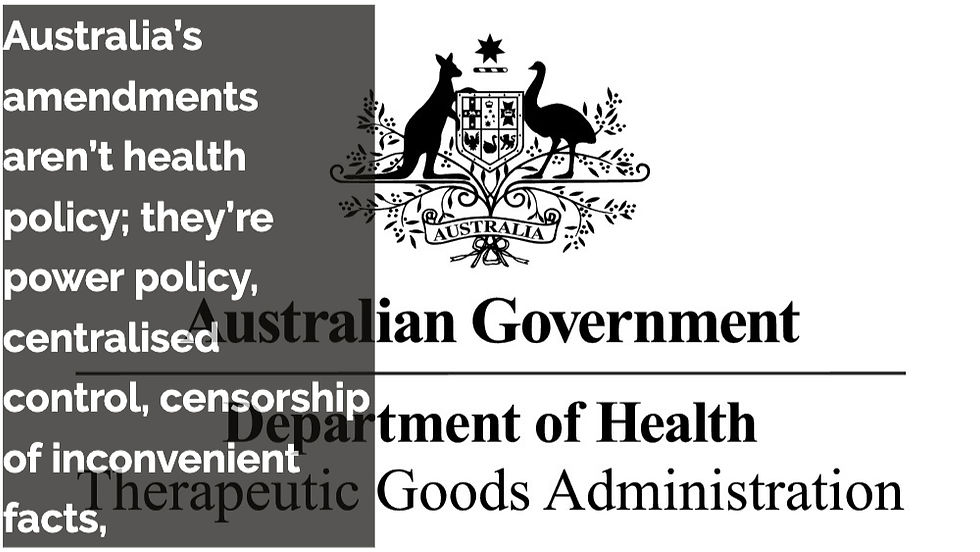Australia’s Vaping “Health” Reforms: Safety Theatre, Power Grab
- Alan Gor

- Aug 25
- 3 min read

Alan Gor 25 August 2025
Australia’s latest vaping amendments aren’t about keeping people safe. They’re about control, handing bureaucrats new powers, silencing inconvenient voices, and choking off legal options so the black market keeps doing a roaring trade. Meanwhile, smokers and vapers bear the costs.
Here’s the plain-English breakdown of what’s really going on.
1) Shoving Vapes into the Therapeutic Goods Act: Safety or Control?
By dumping “vaping goods” into a medicines law, the government can ban or restrict products without proving actual harm, then pile on fees, approvals and paperwork small businesses can’t survive. The result:
Smokers lose choice and stay on cigarettes.
Vapers get criminalised for trying to avoid smoke.
Big Tobacco & Big Pharma face less competition.
Bureaucrats get a fresh toolkit for discretionary crackdowns.
If vaping is a consumer product, regulate it like one: product standards, emissions testing, plain packaging rules if you must, strict age checks, and retail audits. Instead, we’re getting prohibition with a lab coat on.
2) “Generic Information” Rules: Not Advertising—Censorship
The law drags “generic information” (basic facts, educational material) under the ad restrictions umbrella. Translation: Doctors, researchers, and harm-reduction advocates can be muzzled for sharing factual information if it upsets the approved narrative.
Worse, enforcement now leans on vague “public health” justifications rather than proven breaches. That’s not regulation, it’s information control. Australians deserve honest education about safer alternatives, not a one-voice state chorus.
3) Deputising “Helpers” for Raids: Mission Creep on Steroids
Authorised officers can now bring “persons assisting” (police, contractors, private security, whoever) to enter premises, seize goods, and enforce the law. Legally, whatever these helpers do is treated as if the authorised officer did it.
Less training, more force.
Fuzzier accountability.
A wider net to trawl small retailers and adult consumers.
This is how you build a compliance machine, not a health system.
4) Easier Forfeiture & Vague “Public Interest” Powers
The bar shifts from “necessary to protect health” to the woollier “in the interests of public health or safety.” Combine that with smoother forfeiture rules, and you’ve got confiscations on a whim: raid, seize, issue directions, ask questions later.
This isn’t targeted enforcement against bad actors; it’s blank-cheque authority.
5) Packaging Theatre: Endless Tinkering, Zero Quit Impact
New “phasing-in / phasing-out” powers let the government constantly change warnings, inserts, images, and pack features. Old rules overlap with new ones. Retailers chase moving goalposts. Bureaucrats call it “world-leading”.
Meanwhile, nothing about the product changes. Cigarettes remain as deadly and available as ever. Adults who might switch to safer nicotine options? Pushed to the black market by design.
It’s classic nanny-state symbolism: rearranging deck chairs on the Titanic while claiming victory.
Who Wins & Who Loses
Winners
Big Tobacco: fewer legal reduced-risk competitors.
Big Pharma: prescription choke-point protects incumbent products.
Bureaucracies: broader powers, more fees, more control.
Losers
Smokers who wanted a realistic off-ramp.
Vapers treated like criminals for avoiding smoke.
Small retailers are buried in red tape and tripwire rules.
Communities dealing with the violence and corruption that prohibition reliably breeds.
The Reality We’re Ignoring
When you ban the safer thing and tax the deadly thing into oblivion, you don’t kill demand, you gift the market to organised crime. Australia is repeating the same failed playbook: prohibition, moral panic, performative packaging, and “gotcha” raids that barely dent supply.
Other countries have shown a saner path: regulate vapes as adult consumer products with high standards and tough age checks, price them to undercut cigarettes, and hammer anyone who sells to kids. That’s how you reduce smoking and starve the black market.
A Serious Alternative (That Would Actually Help)
Legal, adult access to regulated vapes and nicotine pouches—no prescription gatekeeping.
Hard standards: emissions caps, ingredient disclosure, device safety, batch testing.
Real youth protection: in-store and delivery age-verification, device activation locks, meaningful penalties for breaches.
Tax logic: cheaper than cigarettes to keep the incentive to switch; enough to fund oversight, not smuggling.
Truthful messaging: vaping isn’t for non-smokers; for smokers, it’s far less harmful than lighting tobacco on fire.
Targeted enforcement: hit illicit importers and youth sellers, not adults trying to quit cigarettes.
The Bottom Line
Australia’s amendments aren’t health policy; they’re power policy, centralised control, censorship of inconvenient facts, and a compliance regime that crushes legal alternatives while the illicit trade flourishes.
If we truly want fewer deaths, less disease, and less crime, the path is obvious: regulate smarter, not harsher. Make safer alternatives easier for adults to get than cigarettes. Protect kids with tech and teeth. And stop mistaking packaging, theatre, and raids for public health.


